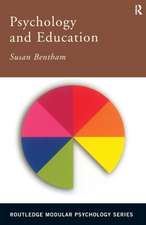Understanding Schematic Learning at Two
Autor Dr Julie Brierley, Professor Cathy Nutbrownen Limba Engleză Paperback – 19 sep 2018
| Toate formatele și edițiile | Preț | Express |
|---|---|---|
| Paperback (1) | 236.45 lei 6-8 săpt. | |
| Bloomsbury Publishing – 19 sep 2018 | 236.45 lei 6-8 săpt. | |
| Hardback (1) | 772.58 lei 6-8 săpt. | |
| Bloomsbury Publishing – 22 mar 2017 | 772.58 lei 6-8 săpt. |
Preț: 236.45 lei
Preț vechi: 305.08 lei
-22% Nou
Puncte Express: 355
Preț estimativ în valută:
45.25€ • 48.38$ • 37.72£
45.25€ • 48.38$ • 37.72£
Carte tipărită la comandă
Livrare economică 17 aprilie-01 mai
Preluare comenzi: 021 569.72.76
Specificații
ISBN-13: 9781350085282
ISBN-10: 1350085286
Pagini: 208
Ilustrații: 30 bw illus
Dimensiuni: 156 x 234 x 17 mm
Greutate: 0.3 kg
Ediția:NIPPOD
Editura: Bloomsbury Publishing
Colecția Bloomsbury Academic
Locul publicării:London, United Kingdom
ISBN-10: 1350085286
Pagini: 208
Ilustrații: 30 bw illus
Dimensiuni: 156 x 234 x 17 mm
Greutate: 0.3 kg
Ediția:NIPPOD
Editura: Bloomsbury Publishing
Colecția Bloomsbury Academic
Locul publicării:London, United Kingdom
Caracteristici
Uses real case studies to show unfolding schematic learning journeys of two-year-olds, offering practical guidance for students and practitioners
Notă biografică
Julie Brierley is Lecturer in Early Years in the School of Education at the University of Hull, UK. Cathy Nutbrown is Professor and Director of Early Childhood Education in The School of Education at The University of Sheffield, UK.
Cuprins
List of FiguresAbout the AuthorsAcknowledgementsIntroductionPart I: The Early Years: Research, Policy and Theory1. Young Children as Actors in Their Own Learning2. Schema Theory3. Early Years Policies and Early Childhood Pedagogies4. The Cultural Nuances of Families' LivesPart II: The Stories of Four Young Children's Schematic Explorations within Their Lived Experiences5. Containing and Dynamic Vertical Trajectory Schema: Abby's Story6. Dynamic Back and Forth, Containing and Enveloping Schemas: Hannah's Story7. Containing, Enveloping and Transporting Schemas: Emily's Story8. Going Around and Through a Boundary Schema: George's StoryConcluding ThoughtsReferences Author IndexSubject Index
Recenzii
Supporting toddlers' schematic learning challenges adults to be knowledgeable about schema theory and attuned to toddlers' sense of agency and motivations that drive play. This new book explores these aspects, and analyses rich examples of young children's schematic explorations to highlight toddlers as intentional meaning-makers of the world around them.
From our own research, we know how enthusiastic practitioners working with two year olds are about ways to extend their practice, and that many had already considered the concept of schema to help them to support children's learning. This book will therefore undoubtedly be welcomed and will help to deepen practitioners' understanding of how two year olds learn. Theoretical underpinnings are set out carefully and clearly and the detailed case studies provide rich insights into the interconnectedness of young children's learning, showing that two year olds are indeed "wondering not wandering" through the world around them.
From our own research, we know how enthusiastic practitioners working with two year olds are about ways to extend their practice, and that many had already considered the concept of schema to help them to support children's learning. This book will therefore undoubtedly be welcomed and will help to deepen practitioners' understanding of how two year olds learn. Theoretical underpinnings are set out carefully and clearly and the detailed case studies provide rich insights into the interconnectedness of young children's learning, showing that two year olds are indeed "wondering not wandering" through the world around them.














